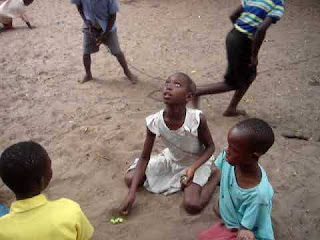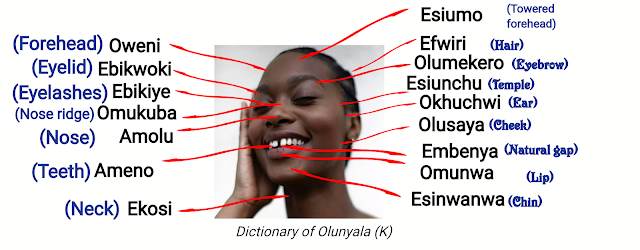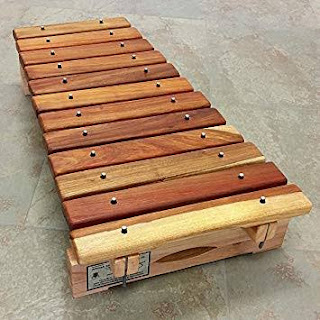ABANYALA: History of the Chronology of Famines
Nobody from Abanyala has ever died of famine. No wonder they always said 'embako si ibeyanga ta,' that is: 'a hoe never lies'. However, that does not mean they have lived in plenty all the years.
Among the Abanyala, famine is defined in term of widespread scarcity of staple food; especially, ugali made from millet flour. Most of the boys born during such seasons were called Wanjala while the girls were called Nanjala.
The following major seasons of famine are documented among the people.
1. Enjala Saba-lulala
This was a minor one that swept across most families in Bunyala in 1997. It was characterised by people eating only one meal in a day.
2. Enjala ya Ekorokoro
It affected Abanyala in 1980. It was at this time that the government imported yellow maize. It was marked by the introduction of the new method of measuring cereals using a two-kilogram tin called ekorokoro. It was caused by drought and economic instability in the region.
The same phenomenon was also sweeping across Uganda due to political instability and drought. It witnessed the naming of people born at this time as Mukorokoro.
3. Enjala ya Ekilo
This was witnessed in1971. It was at this time that Kenya was changing from the currency of King George to Kenyatta's currency. It was occasioned by draught. The unit of measuring also turned to kilograms from pound system. Children born during this time were called Kilo.
4. Enjala ya Mau Mau
This was as from 1956 to 1958. It was caused by scarcity of food in the neighbourhood of Bunyala. This was occassioned by whites who came around forcing men to go and work on farms they had forcefully acquired. Most of the men feared working on their own farms for they could be seen and taken away. They also thought their farms were going to be forcefully taken. Though a few Abanyalas were affected, the many affected foreigners flocked to Bunyala for cereals reducing the stock leading to famine.
5. Enjala ya Esike
Some mild swarm of locust swept across the region in 1960. This was them followed by a strong influx of armyworms that devoured crops. This is the time embama and potatoes saved the people whoon were poor. Most people trapped, boiled and stored locusts and armyworms for use as meal. Though the effect was due to armyworms more than locusts, the name after locust was used.
The esike was also followed by an outbreak of small pox in most of the regions.
6. Enjala ya Esikombe
This was happened in 1944. It was as extension of the effects of the famine of Panyako. Though there was no scarcity in Bunyala, its effects were felt. Fear of war had made people not to prepare farms. The people were given meal in a cup hence the name.
7. Enjala ya Muyonga
This was an extension of that of 1942 that greatly affected people in 1943. It was believed that a man called Muyonga was the only one who had hoarded food leading to famine.
8. Enjala ya Panyako
This was felt in 1942. It was due to the far reaching effects of Second World War. Banyala men were being forced into the war. These who refused the call to join were told to 'Pack and go!' This was perceived as 'Panyako.' The Abanyalas called it the war of 'mu-lazima'. It is narrated that some hunted and trapped eatible rats for food.
A dirge composed by a woman moarning his only son who died during this time has it that there was a fat whiteman called Bwana Recha (Sergeant Major) who raided homes picking cereals and cattle to take to the captured Africans.
9. Enjala ya Nyangweso (Nyapola)
It happened from 1930 to 1931. It was caused by locusts that attacked the neighbourhood of Bunyala and mass death of cattle due to anthrax. Preparation of land become affected. By this time, Abanyala had enough food stock but witnessed influx of foreigners who were in need of food. Some came with children that they left behind as cattle tenders in exchange of food.
The famine was believed to have originated from land of Kisii and Luo due to the curse by a medicine man called Nyangweso. He was revenging the mob justice meted against his father-law who had gone begging.
This witnessed the naming of men as Nyangweso such as Nyangweso the son of Balongo among the Abasamama and Nyangweso the father to the legendary footballer called Benjamin.
10. Enjala ya Keya
This swept across Bunyala between 1918 to 1919. It was due to men being forcefully taken to fight in K.A.R. (Keya) Boys were born and named Keya. The men who had gone for second world War left farms uncultivated. This famine was across East Africa. It was called the famine of Rumanura in Rwanda and Burundi.
11. Enjala ya Wadongo
This affected the people in 1890. Only mild effect was felt in Bunyala. It was known as the famine of Odongo in other regions. It witnessed many foreigners coming to borrow food. Odongo was an agent of a white man who was scaring people that the whiteman was going to take their lands. This made people not to till land.
12. Enjala ya akhayindikiri
It was witnessed in 1888. There was an outbreak of rinderpest across the region that killed cattle. It witnessed the introduction of a small basket for measuring cereals called akhayindikiri.
14. Enjala ya Nasookho (Eya-sookho)
The long dry spell that lead to downfall of Nasookho was labelled such. This is what proped Masiribayi to to take power power.
15. Enjala ya Lumale
It was occassioned by the dry spell of 1845-1850. This was compounded by the nagging fear that the clan that the Abanyala combined warriors had helped to expell in 1800 AD had been asked to come back to their land by the same Abanyala Abaongo. The Abaongo claimed the dry spell was because their god was angry for sending Abakhoone away. Due to this, (as well as locusts and Teso attacks) the people always felt insecure leading to their further emigration.
16. Enjala ya amachungu
This happened in 1720 across many communities leading to further splits since some families were said to have called the many rats that roamed around carrying fleas and causing deseases among people. Most people died, were sick and did not participate in serious farming. The crops in farms and stores were also destroyed by rats.
16. Enjala ya Esiadikho
This happebed in 1710 AD. It followed the attack on Abanyala by Abakhoone leading to their split into three: one group remained in Busia. Another group (Kabras) headed far East. Onother group sought refuge in the neighbouring clans of Abakholo, Abanyekera, Abawanga, Abamasaba and Abanyuli. They become labourer for other clans. The took some time to recollect themselves under one group. It witnessed names such as Namwatikho.
Among the Abanyala, famine is defined in term of widespread scarcity of staple food; especially, ugali made from millet flour. Most of the boys born during such seasons were called Wanjala while the girls were called Nanjala.
The following major seasons of famine are documented among the people.
1. Enjala Saba-lulala
This was a minor one that swept across most families in Bunyala in 1997. It was characterised by people eating only one meal in a day.
2. Enjala ya Ekorokoro
It affected Abanyala in 1980. It was at this time that the government imported yellow maize. It was marked by the introduction of the new method of measuring cereals using a two-kilogram tin called ekorokoro. It was caused by drought and economic instability in the region.
The same phenomenon was also sweeping across Uganda due to political instability and drought. It witnessed the naming of people born at this time as Mukorokoro.
3. Enjala ya Ekilo
This was witnessed in1971. It was at this time that Kenya was changing from the currency of King George to Kenyatta's currency. It was occasioned by draught. The unit of measuring also turned to kilograms from pound system. Children born during this time were called Kilo.
4. Enjala ya Mau Mau
This was as from 1956 to 1958. It was caused by scarcity of food in the neighbourhood of Bunyala. This was occassioned by whites who came around forcing men to go and work on farms they had forcefully acquired. Most of the men feared working on their own farms for they could be seen and taken away. They also thought their farms were going to be forcefully taken. Though a few Abanyalas were affected, the many affected foreigners flocked to Bunyala for cereals reducing the stock leading to famine.
5. Enjala ya Esike
Some mild swarm of locust swept across the region in 1960. This was them followed by a strong influx of armyworms that devoured crops. This is the time embama and potatoes saved the people whoon were poor. Most people trapped, boiled and stored locusts and armyworms for use as meal. Though the effect was due to armyworms more than locusts, the name after locust was used.
The esike was also followed by an outbreak of small pox in most of the regions.
6. Enjala ya Esikombe
This was happened in 1944. It was as extension of the effects of the famine of Panyako. Though there was no scarcity in Bunyala, its effects were felt. Fear of war had made people not to prepare farms. The people were given meal in a cup hence the name.
7. Enjala ya Muyonga
This was an extension of that of 1942 that greatly affected people in 1943. It was believed that a man called Muyonga was the only one who had hoarded food leading to famine.
8. Enjala ya Panyako
This was felt in 1942. It was due to the far reaching effects of Second World War. Banyala men were being forced into the war. These who refused the call to join were told to 'Pack and go!' This was perceived as 'Panyako.' The Abanyalas called it the war of 'mu-lazima'. It is narrated that some hunted and trapped eatible rats for food.
A dirge composed by a woman moarning his only son who died during this time has it that there was a fat whiteman called Bwana Recha (Sergeant Major) who raided homes picking cereals and cattle to take to the captured Africans.
9. Enjala ya Nyangweso (Nyapola)
It happened from 1930 to 1931. It was caused by locusts that attacked the neighbourhood of Bunyala and mass death of cattle due to anthrax. Preparation of land become affected. By this time, Abanyala had enough food stock but witnessed influx of foreigners who were in need of food. Some came with children that they left behind as cattle tenders in exchange of food.
The famine was believed to have originated from land of Kisii and Luo due to the curse by a medicine man called Nyangweso. He was revenging the mob justice meted against his father-law who had gone begging.
This witnessed the naming of men as Nyangweso such as Nyangweso the son of Balongo among the Abasamama and Nyangweso the father to the legendary footballer called Benjamin.
10. Enjala ya Keya
This swept across Bunyala between 1918 to 1919. It was due to men being forcefully taken to fight in K.A.R. (Keya) Boys were born and named Keya. The men who had gone for second world War left farms uncultivated. This famine was across East Africa. It was called the famine of Rumanura in Rwanda and Burundi.
11. Enjala ya Wadongo
This affected the people in 1890. Only mild effect was felt in Bunyala. It was known as the famine of Odongo in other regions. It witnessed many foreigners coming to borrow food. Odongo was an agent of a white man who was scaring people that the whiteman was going to take their lands. This made people not to till land.
12. Enjala ya akhayindikiri
It was witnessed in 1888. There was an outbreak of rinderpest across the region that killed cattle. It witnessed the introduction of a small basket for measuring cereals called akhayindikiri.
14. Enjala ya Nasookho (Eya-sookho)
The long dry spell that lead to downfall of Nasookho was labelled such. This is what proped Masiribayi to to take power power.
15. Enjala ya Lumale
It was occassioned by the dry spell of 1845-1850. This was compounded by the nagging fear that the clan that the Abanyala combined warriors had helped to expell in 1800 AD had been asked to come back to their land by the same Abanyala Abaongo. The Abaongo claimed the dry spell was because their god was angry for sending Abakhoone away. Due to this, (as well as locusts and Teso attacks) the people always felt insecure leading to their further emigration.
16. Enjala ya amachungu
This happened in 1720 across many communities leading to further splits since some families were said to have called the many rats that roamed around carrying fleas and causing deseases among people. Most people died, were sick and did not participate in serious farming. The crops in farms and stores were also destroyed by rats.
16. Enjala ya Esiadikho
This happebed in 1710 AD. It followed the attack on Abanyala by Abakhoone leading to their split into three: one group remained in Busia. Another group (Kabras) headed far East. Onother group sought refuge in the neighbouring clans of Abakholo, Abanyekera, Abawanga, Abamasaba and Abanyuli. They become labourer for other clans. The took some time to recollect themselves under one group. It witnessed names such as Namwatikho.



Excellent documentation my brother
ReplyDeleteExcellent job done sire..am a great follower of your articles
ReplyDeleteExcellent job done sire..am a great follower of your articles
ReplyDeleteGood work and documentation. A history many would have missed
ReplyDeleteLove your articles so much. So educative.
ReplyDeleteGreat research! Kindly consider the World War inputs. Carrier Corps (Kariokor) and Pioneer Corps (Panyako). Thank you!
ReplyDelete